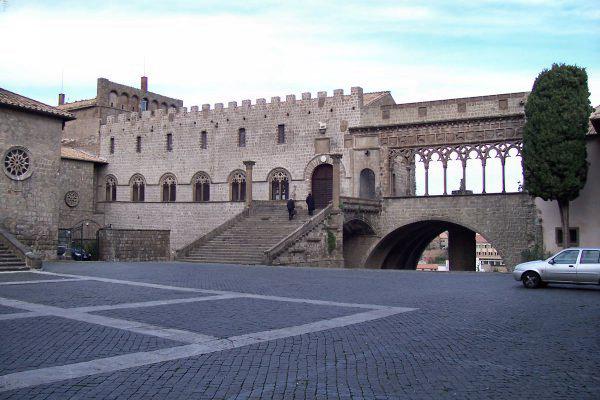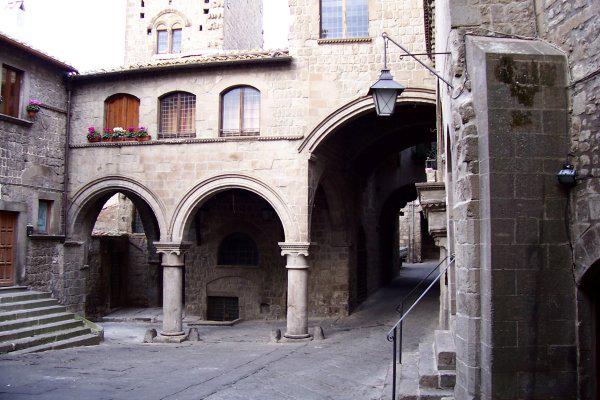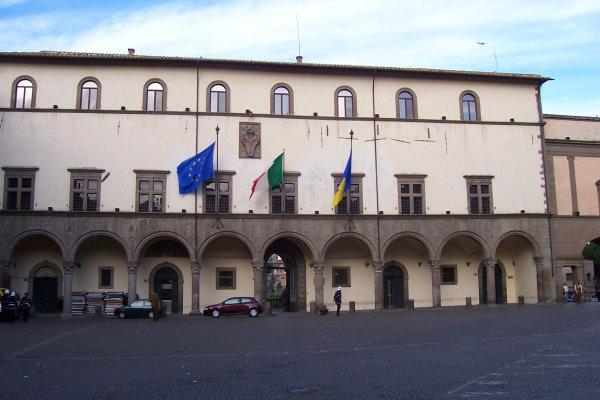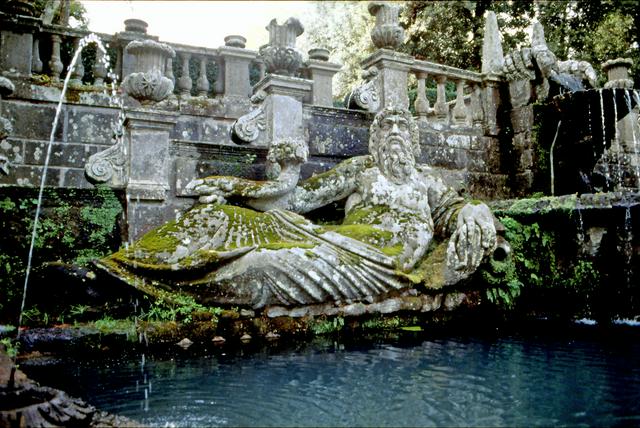Viterbo is in Lazio, a central region of Italy.

As a settlement Viterbo dates back to Etruscan times. Between around 1100 and 1300, it was one of the most important cities in Europe. By the 13th Century it had 50 castles under its control. It was the place where Popes took refuge when driven out of Rome and for several decades was the seat of the Papacy. It was the scene of battles between potential invaders of Rome and papal armies. With the departure of the Papacy to Orvieto and then to Avignon Viterbo declined in importance. It was further hit by Black Death, which killed two-thirds of its population and a major earthquake in 1349. Last century it was damaged by appalling Fascist-era town planning and then by Allied bombs. These days its population is about the same as it was in the 13th Century, at around 60,000. Apart from its tradition its main claim to fame now is that Italy’s gold reserves are held there.


- Viterbo Cathedral. The cathedral dates back to the 12th Century but the façade is 16th Century and the tower 14th. There is a tomb for Pope John XXI. Pope Alexander IV was also buried there but his tomb was unaccountably destroyed during 16th Century renovations. According to legend the cathedral was built on the site of an Etruscan temple to Hercules.
- Palazzo dei Papi. This was formerly the bishop’s residence but was enlarged for the popes. It was the papal seat between 1257 and 1281 and hosted six popes. It was the site of the first Papal Conclave when the local people got so fed up with the cardinals taking too long to elect a pope that they locked them all in until they came to a decision. The practice continues to this day in the Sistine Chapel at the Vatican.
- Church of San Francesco. Built in the 13th century in Romanesque-Gothic style, this church was completely destroyed by bombs in 1944. It was reconstructed in 1953. There is the superb mausoleum of Pope Hadrian V, who died in Viterbo in 1276 and the mausoleum of Pope Clement IV, who died in Viterbo in 1268. There are also remains of the tomb of the so-called “Pope-of-one-day”, Cardinal Vicedomino Vicedomini, who would have become Gregory XI, if he had not died the night after his election.
- Palazzo dei Priori. This originally dates back to 1263. Inside there is a garden court with arcades of 1682 with an elegant Baroque fountain and a beautiful view. There are some interesting frescoes.
- Church of S. Maria Nuova. This is one of the most ancient churches in Viterbo, built in 1080 on the remains of a temple.Externally, on the left, there is a pulpit on a column, from where St. Thomas Aquinas preached. The church has a wide range of Viterbese frescoes and paintings from between the 14th and the 16th Centuries. In the apse of the left aisle there is a precious tryptych from 1180 painted on leather with the effigy of Christ.
- Rocca Albornoz, Piazza della Rocca, 21/b. 8:30 to 19:30 except Mondays. This castle was greatly destroyed by the bombings in 1944. It took over a century to build and was finally completed in 1462. The Rocca Albornoz houses a national archeological museum (Museo Nazionale) with a permanent exhibition on Etruscan and other cultures. € 2,00.
- Piazza Commune. That's where the Government Palace is.

- Villa Lante, Via Jacopo Barozzi, 71, località Bagnaia (approx. 10 min. by bus from city centre; the closest bus stop to the railway station is v.le Trieste /N.Sauro-Gorizia.; direction Orte Scalo - Staz.FS, 'Soriano nel Cimino - Papacqua, Gallese Teverina FS - Staz.FS; get off at v.le Fiume (Viterbo)., +39 0761 288008. Nov-Feb Tu-Su 8:30-16:30; Mar,Oct Tu-Su 8:30-18:30; Apr-Sep Tu-Su 8:30-19:30;. A Mannerist villa with a garden at the Bagnaia suburb. €5.
Villa Lante, Via Jacopo Barozzi, 71, località Bagnaia (approx. 10 min. by bus from city centre; the closest bus stop to the railway station is v.le Trieste /N.Sauro-Gorizia.; direction Orte Scalo - Staz.FS, 'Soriano nel Cimino - Papacqua, Gallese Teverina FS - Staz.FS; get off at v.le Fiume (Viterbo)., +39 0761 288008. Nov-Feb Tu-Su 8:30-16:30; Mar,Oct Tu-Su 8:30-18:30; Apr-Sep Tu-Su 8:30-19:30;. A Mannerist villa with a garden at the Bagnaia suburb. €5.
Viterbo Cathedral. The cathedral dates back to the 12th Century but the façade is 16th Century and the tower 14th. There is a tomb for Pope John XXI. Pope Alexander IV was also buried there but his tomb was unaccountably destroyed during 16th Century renovations. According to legend the cathedral was built on the site of an Etruscan temple to Hercules.
Palazzo dei Papi. This was formerly the bishop’s residence but was enlarged for the popes. It was the papal seat between 1257 and 1281 and hosted six popes. It was the site of the first Papal Conclave when the local people got so fed up with the cardinals taking too long to elect a pope that they locked them all in until they came to a decision. The practice continues to this day in the Sistine Chapel at the [[Rome/Vatican|Vatican]].
Church of San Francesco. Built in the 13th century in Romanesque-Gothic style, this church was completely destroyed by bombs in 1944. It was reconstructed in 1953. There is the superb mausoleum of Pope Hadrian V, who died in Viterbo in 1276 and the mausoleum of Pope Clement IV, who died in Viterbo in 1268. There are also remains of the tomb of the so-called “Pope-of-one-day”, Cardinal Vicedomino Vicedomini, who would have become Gregory XI, if he had not died the night after his election.
Palazzo dei Priori. This originally dates back to 1263. Inside there is a garden court with arcades of 1682 with an elegant Baroque fountain and a beautiful view. There are some interesting frescoes.
Church of S. Maria Nuova. This is one of the most ancient churches in Viterbo, built in 1080 on the remains of a temple.Externally, on the left, there is a pulpit on a column, from where St. Thomas Aquinas preached. The church has a wide range of Viterbese frescoes and paintings from between the 14th and the 16th Centuries. In the apse of the left aisle there is a precious tryptych from 1180 painted on leather with the effigy of Christ.
Rocca Albornoz, Piazza della Rocca, 21/b. 8:30 to 19:30 except Mondays. This castle was greatly destroyed by the bombings in 1944. It took over a century to build and was finally completed in 1462. The Rocca Albornoz houses a national archeological museum (Museo Nazionale) with a permanent exhibition on Etruscan and other cultures. € 2,00.
Piazza Commune. That's where the Government Palace is.
- Thermal springs
Already famous in Roman times, and quoted by Dante in his "Divine Comedy"...having a bath in one of their natural thermal springs is, perhaps, what you would never miss from Viterbo. As they are in surrounding open-air countryside areas, you can use them all year, every time of the day (for free, of course). Water reaches temperatures of 55°C, so the experience gets more amazing in freezing days (and nights).
The most famous ones are called Bulicame (2 km from Viterbo, on the road that leads to Tuscania). On the other hand there are also some springs run as spas centres (Terme dei Papi and Pianeta Benessere)
Thermal springs
- La Buca di San fastino. Wonderful family restaurant with delicious food! And really cheap too. 10 euros for primo, secondo, plus contorni.
- Il Monastero, Via Fattungheri, 10. Huge and delicious pizzas around €5.
- Also good is Pizzeria San Pelligrino, on Via San Pelligrino.
- Tre Re at Piazza Del'Erbe has excellent pastas and other Viterbese fare for about €10-€20 per person.
- Il Laberinto. Great cheaper restaurant just a few steps away from Il Monastero.
- Convivium, piazza della Morte, 14, +39 0761324397. Recently opened. delicious apertivs, dinner, and wine.
- Tredici Gradi, Piazza Don Mario Gargiuli, 11 & Piazza del Gesu', 18, +39 0761-305596. Restaurant, bar, & wine bar (vineria con cucina e slow bar) The menu varies daily, by season & the mood of the cook. Fantastic food & amazing antipasti featuring regional artisanal meats, cheeses & other delicacies. Simply amazing food & a great experience. The also have a sell lots of goodies typical of the region to take back home including an incredible wine selection.
La Buca di San fastino. Wonderful family restaurant with delicious food! And really cheap too. 10 euros for primo, secondo, plus contorni.
Il Monastero, Via Fattungheri, 10. Huge and delicious pizzas around €5.
Il Laberinto. Great cheaper restaurant just a few steps away from Il Monastero.
Convivium, piazza della Morte, 14, +39 0761324397. Recently opened. delicious apertivs, dinner, and wine.
Tredici Gradi, Piazza Don Mario Gargiuli, 11 & Piazza del Gesu', 18, +39 0761-305596. Restaurant, bar, & wine bar (vineria con cucina e slow bar) The menu varies daily, by season & the mood of the cook. Fantastic food & amazing antipasti featuring regional artisanal meats, cheeses & other delicacies. Simply amazing food & a great experience. The also have a sell lots of goodies typical of the region to take back home including an incredible wine selection.
- "Caffe Cavour" on Via Cavour, has the best cappuccino in town.
- "Blitz" - great food and drinks
- "Shu Lounge" - pricey drinks, nice outdoor seating, good music, friendly workers
Viterbo is the center of a really fascinating area and there are many places that can be explored by car in an easy day trip. To the east is the Etruscan city of Tarquinia, to the north Orvieto and in a general southerly direction places such as the park of monsters at Bomarzo and the Etruscan/Roman remains of Sutri should not be missed.
